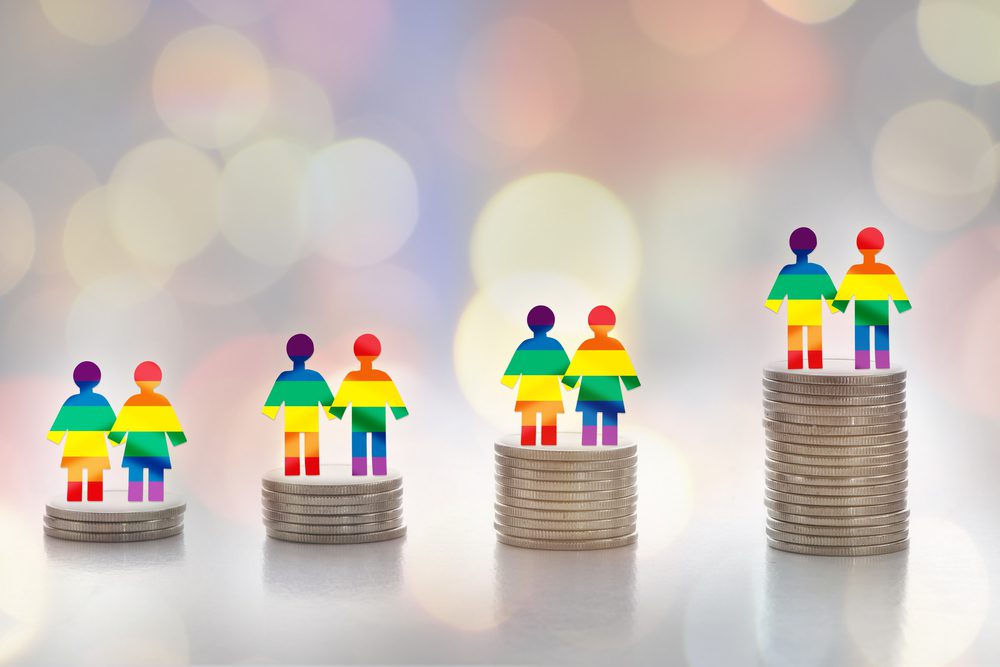Advertiser Disclosure: Many of the companies featured here provide compensation to us. This is how we maintain our free service for consumers. Compensation, along with hours of in-depth editorial research, determines where & how companies appear below.
There have been a lot of historical, societal, and legal changes that grant the LGBTQ+ community more equality and protection. However, they still face unique challenges, including money.
It’s essential to recognize LGBTQ+ financial issues, whether they stem from legal disparities or personal concerns. Defining the problems will help bring attention to them and come up with solutions.
This article will provide an overview of the financial issues LGBTQ+ people face with marriage and family planning, debt, insurance, and retirement—sometimes because of a history of discrimination against LGBTQ+ communities, but also because being LGBTQ+ has its financial challenges.
What You Need To Know
- Many changes and movements for LGBTQ+ rights have occurred relatively recently, so members of these communities are still learning to cope financially with their specific challenges.
- On average, LGBTQ+ people save less for retirement.
- Compared to cisgender/heterosexuals, LGBTQ+ people owe $16,000 more on student loans.
- You can easily spend tens of thousands of dollars on family planning for LGBTQ+ people.
- Some LGBTQ+ retirees may have less saved for retirement and want to retire to an accepting community with higher living costs.
Discrimination in History

Historically, LGBTQ+ people have been discriminated against in the United States. Gay marriage was legalized in all 50 states only in 2015. It was not until 2020 that the Supreme Court prohibited discrimination in employment decisions based on sexual orientation or gender identity. However, these are just some of the concerns LGBTQ+ individuals face today.
As the years have passed, various laws have been given, and notable events have helped and hurt members of the LGBTQ+ community. Below are some fundamental rules and moments that have significantly shaped the world and the issues they face today.
- 1969: The Stonewall Uprising took place at the Stonewall Inn in New York City in 1969, often cited as a catalyst for LGBTQ+ rights.
- 1974: The Equal Credit Opportunity Act (ECOA) of 1974 forbids lending discrimination based on race, color, religion, national origin, sex, marital status, age, or receipt of government aid, but it does not mention sexual orientation or gender identity.
- 1977: As one of the first openly gay elected officials, Harvey Milk was assassinated after serving less than a year on the San Francisco Board of Supervisors.
- 1988: The Fair Housing Act, passed in 1968 and amended in 1988, protects Americans from discrimination based on race, color, national origin, religion, sex, family status, and disability but omits gender identity and sexual orientation.
- 1994: “Don’t Ask, Don’t Tell” is instituted, banning openly gay and lesbian military members from serving.
- 2009: Barack Obama signs a Presidential Memorandum allowing same-sex partners of federal employees to get benefits but not health care.
- 2010: “Don’t Ask, Don’t Tell” is repealed, allowing gays and lesbians to serve openly.
- 2015: In Obergefell v. Hodges, the U.S. Supreme Court legalized same-sex marriage in all 50 states.
- 2019: The Fair and Equal Housing Act of 2019 was introduced in the U.S. Senate. It would have protected sexual orientation and gender identity from discrimination in credit lending. But it didn’t get a vote, so it didn’t pass. Currently, the bill hasn’t been reintroduced.
- 2020: The U.S. Supreme Court ruled in Bostock v. Clayton County that discrimination based on sexual orientation or gender identity is illegal.
- 2021: The Consumer Financial Protection Bureau (CFPB) clarifies that the ECOA includes protections for LGBTQ+ people, making discrimination against them illegal.
There’s been a lot of change and movement for LGBTQ+ rights over the last 50 years. The monumental changes outlined above show how LGBTQ+ communities have struggled and triumphed. Some LGBTQ+ communities are still impacted by the long period without rights and protections, like marriage and workplace protections, because some rights and protections only came about recently.
For LGBTQ+ people, these milestone events have had substantial financial repercussions. Whether it was leaving out protections against discrimination or granting rights (such as health coverage and marital status tax and other benefits), these events shaped LGBTQ+ people’s financial future in various ways, including personal finance, debt, insurance, retirement, and others. These areas help bring attention to LGBTQ+ financial struggles.
LGBTQ+ Marriage and Family Planning

The right to legally marry changed the landscape for LGBTQ+ people. With it came spousal benefits like Social Security, pensions, and jobs. In addition to being able to file taxes together, married couples also avoided enormous tax burdens when getting pension payouts from deceased partners.
No matter if LGBTQ+ people marry or not, they face financial challenges. Adoption, in vitro fertilization (IVF), surrogacy, and artificial insemination are all expensive ways to start a family for LGBTQ+ people.
Whether you’re adopting domestically or internationally, adoption can cost $20,000 to $75,000. IVF can cost $13,500 to $21,000 or more and thousands more per try. Surrogacy can cost less than $60,000 to more than $150,000, depending on the type.
It’s hard to pay these costs for most couples or individuals. The difference is that nearly all LGBTQ+ people face them when they start a family.
Furthermore, some states don’t allow gestational surrogacy or have proposed laws outlawing IVF, so there are legal and financial challenges.
Debt and LGBTQ+ People
A study by Student Loan Hero shows that LGBTQ+ people carry $16,000 more student loan debt than their cisgender/heterosexual peers. Many factors can cause this problem, including students without financial support from parents who won’t fund their LGBTQ+ kids’ education.
Student loan debt often leads to financial struggles in other areas, too: 41% of LGBTQ+ folks reported being unable to buy a house or car because of their student loans.
Aside from student loan debt, debt generally appears to be top of mind for many LGBTQ+ people. According to a survey from Experian, 20% of LGBTQ people are worried about paying off debt. Not to mention, 75% use credit cards to buy stuff.
The insurance issues faced by LGBTQ+ people
When it comes to insurance, LGBTQ+ people face unique challenges. According to the Movement Advancement Project, “42% of [the] LGBTQ population lives in states that include sexual orientation and gender identity insurance protections,” which means about half of LGBTQ+ people are covered by insurance.
The healthcare of LGBTQ+ people is often threatened by laws that allow discrimination in healthcare. The first day President Biden was in office in January 2021, he issued an executive order that expanded nondiscrimination protections for LGBTQ+ people, including healthcare.
Gender confirmation surgeries can be a considerable expense, costing in the tens of thousands—they can exceed $100,000—and aren’t always covered by insurance. Some transgender people turn to fundraise sites like GoFundMe for help paying for these surgeries, whether they have insurance or not.
Retirement and LGBTQ+ People

According to a Prudential study, LGBTQ+ people make less money, contributing to their lower retirement savings. They also have less investment for retirement as a group.
It says gay men make $56,936 on average, while straight men make 46% more: $83,469 on average. Lesbians get $45,606 on average; straight women get $51,461. (This second group of figures conflicts with other studies that say lesbians tend to earn more than heterosexual women, such as a 2014 analysis of 29 studies.
Bisexual men earn $85,084 on average, and bisexual women make $35,980. UCLA’s Williams Institute found bisexuals earn less than gays and straight.
In terms of retirement, there’s less information available for transgender people. Still, the U.S. Transgender Survey from the National Center for Transgender Equality says transgender people are more likely to live in poverty, so they’re less likely to save for retirement. A 2011 report from the National LGBTQ Task Force found that 15% of transgender people had household incomes under $10,000.
As a result of marriage inequality, LGBTQ+ people faced retirement issues until recently. Because they weren’t legally married, they couldn’t transfer Social Security, pensions, or other retirement plans (if they could, not easily).
For example, before 2006’s Pension Protection Act (PPA), unmarried beneficiaries had to take any retirement funds as lump-sum payments. This created a huge tax burden for the beneficiary and prevented them from receiving continuous payments over time, which would have been more beneficial for them. IRAs and other retirement plans favor people who inherit from a spouse (rather than those who are not spouse beneficiaries); it’s essential to be able to inherit as a spouse legally.
It’s also common for people in LBGTQ+ communities to have different needs in retirement. For their post-employment years, LGTBQ+ people often look for accepting areas of the country. For LGBTQ+ people, retirement can be more expensive because they have to live in cities where housing and living costs can be way above the national average.
Conclusion
Aside from the ones outlined here, LGBTQ+ communities face other financial challenges. With recent changes, like the Supreme Court ruling in 2020 that gave LGBTQ+ people federal nondiscrimination protections, along with Biden’s executive order expanding those protections, we’re making progress.
Advocates push for further changes, such as passing the Equality Act, which would expand the Civil Rights Act of 1964 and several other laws, and whose impacts would extend to employment, housing, credit, education, public spaces, services, federally funded programs, and jury service for LGBTQ+ individuals.
As LGBTQ+ rights advocacy continues and the community gets more legal protections, the financial burden of LGBTQ+ Americans might start to go down.




